Written on: June 1, 2012 by Paul J. Nazzaro
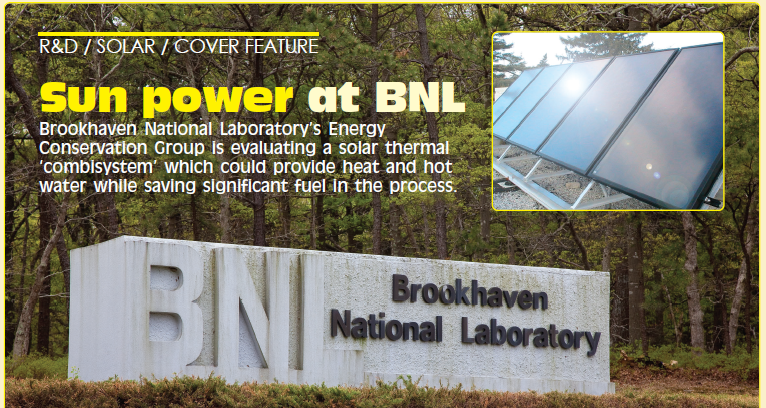
If you’ve ever seen the Syfy channel cable series Eureka, about a mythical, secret town in the U.S. populated by the nation’s most brilliant scientists, you might wonder whether such places really exist. Well, pretty much, they do. In fact, depending on how you count, the Department of Energy alone has 12 to 16 of them. While they may not have developed faster than light space drives or true artificial intelligence (at least we don’t think so), they are definitely doing research on the cutting edge. They’re our National Laboratories.
We are interested in one particular lab, the only one on the East Coast: Brookhaven National Laboratory (BNL). This facility, situated on the site of a World War I military base in Upton, New York (Long Island), sprawls over 5,320 acres with 330 buildings (and counting), employs over 2,800 individuals, educates 1,500 students and hosts 4,354 facility users. BNL’s advanced research covers the gamut from particle and nuclear physics, condensed matter physics and materials science, to climate change, nanoparticles , superconductors and a whole lot more.
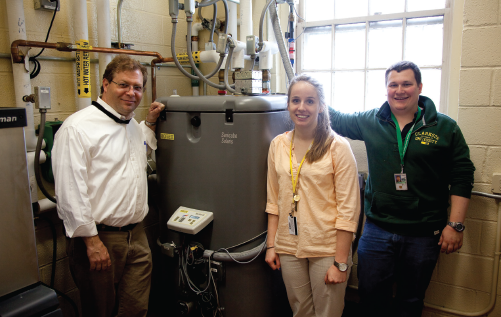
Jon Longtin, Rebecca Trojanowski and Chris Brown with the integrated storage tank
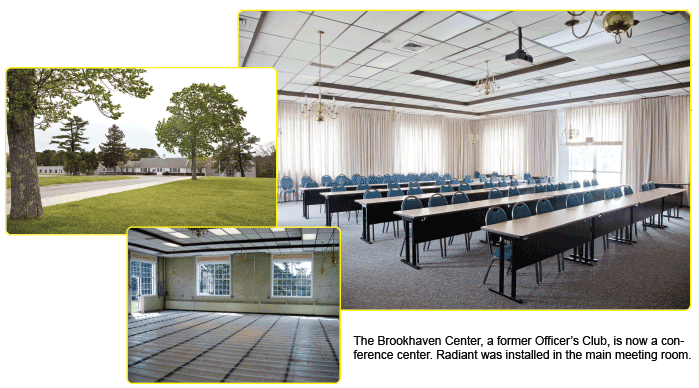 Sponsors include the New York Energy Conservation and Development Authority (NYSERDA), The DoE Federal Energy Jon Longtin, Rebecca Trojanowski and Chris Brown with the integrated storage tank Photo: Mike SanGiovanni, ICM Large photo: Mike SanGiovanni, ICM; inset: BNL 18 ICM/June 2012 Management Program, BNL facilities and Rotex GmbH (the German manufacturer of the system tested). The project was designed to evaluate a “combisystem” which integrates solar collectors, a condensing boiler, storage, low temperature heat distribution and con- trols in “system to meet space heating and domestic hot water loads.”
Sponsors include the New York Energy Conservation and Development Authority (NYSERDA), The DoE Federal Energy Jon Longtin, Rebecca Trojanowski and Chris Brown with the integrated storage tank Photo: Mike SanGiovanni, ICM Large photo: Mike SanGiovanni, ICM; inset: BNL 18 ICM/June 2012 Management Program, BNL facilities and Rotex GmbH (the German manufacturer of the system tested). The project was designed to evaluate a “combisystem” which integrates solar collectors, a condensing boiler, storage, low temperature heat distribution and con- trols in “system to meet space heating and domestic hot water loads.”
Indoor Comfort Marketing’s Editor, Mike SanGiovanni, visited BNL to discuss the project with the team members. Dr. Jon Longtin hosted the visit, accompanied by Chris Brown, Rebecca Trojanowski and George Wei. Other team members involved in the project include Yusuf Celebi, Mark Toscano, Chris Channing, Dan Farge and Chuck Schuster.
Dr. Longtin said one of the major project goals is to evaluate such combisystems, which are common in Europe, but not in the U.S. The idea is to implement the European model and see if it is worthwhile to implement here, with a secondary goal of extracting a realistic view of the practicality of combisystems. For example, one concern is how robust the system is in terms of maintaining its design efficiency if portions of the system are not functioning at their optimal level, or the system parameters are not set correctly. “These are complicated systems, with operating decisions being made by several separate controllers across the system,” Longtin said. “It only takes one incorrect setting or outof- bounds parameter to significantly alter the system behavior.”
Finally, taking all they learned from the project, a third goal would be to determine how it could be improved; in essence, they were creating a future research tool.
Once they established the direction the project would take, it became a matter of how to best implement the testing procedure. They decided to test in a real-life situation, rather than simulating conditions in the lab. They wanted a building that was in use.
The first step was to find the right building for a field test, and, since there are more than 300 at BNL, they had a pretty good chance of locating what they needed. The ideal building would need solar exposure, which basically translates to having a flat roof. And roof accessibility was important, as adjustments to the solar collectors would most likely be needed on occasion.
The building also needed a connection to the mechanical room and ideally, it needed a satellite building with a local boiler and water heater. The building chosen was “The Brookhaven Center” and it filled the bill quite well: This building used to be the Officers Club when the lab was an Army Training Base in World War II. It is now used regularly at a meeting and conference center.
The main building, of original wood frame construction with a sloped room on a concrete slab, features two later additions, both of concrete block with flat roofs and partial basement.
The local boiler provided steam heat and consumed 11,000 gallons of fuel oil annually to heat the 14,295 ft2 space.
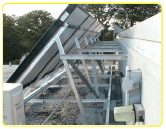
One of the flat roofs was ideal for placement of the solar collectors. It was only one story up, accessible by short ladder, and the collectors could be positioned for maximum sun gain. Five solar collectors were installed. They were supplied as part of the combisystem by Rotex (model V26A Flat Plate). The five collectors (photos, right and on following page) collectively provide 13 square meters total area and the panels are of the dry design (more on that below).

The unusual Rotex design, with its cast aluminum shell and stainless steel tubes, is, as are many European boilers, a condensing type fired by a low-NOx blue flame burner firing B-20 (20% biofuel/80% no. 2 fueloil). The new boiler, said Chris Brown, is roughly 92% efficient. Its primary role is space heating, with supplemental heat for the domestic hot water system.
One conference room was chosen. It had considerable window exposure and a slab floor. The slab was retrofitted with radiant PEX tubing over which was poured a concrete floor. The radiant valve distributes heated water to four zones beneath the floor, heating the room more quickly and uniformly, although the four zones are not individually controlled.
The integrated storage tank, a 500 liter (132 gallon) unit provides hot water for the radiant heating and for domestic hot water. It features three separate coils within the tank. The main body of the unpressurized tank is filled with ordinary tap water, which is heated by the Solaris unit via the roof panels. The tank contains three individual coils. One is a stainless steel coil running the entire length of the temperature stratified tank. Water is circulated from the older oilfired hot water heater through this coil, which is surrounded by water heated Left and below, Mike SanGiovanni, ICM; radiant installation: BNL BNL BNL The Brookhaven Center, a former Officer’s Club, is now a conference center. Radiant was installed in the main meeting room. ICM/June 2012 19 by the Solaris unit and, if necessary, by a second stainless steel heat exchanger (from the boiler) that supplements on cloudy days.
A third, smaller coil is used for the space heating requirements. It’s smaller because radiant doesn’t require extremely hot water. The diagram on the facing page shows the coil arrangement.
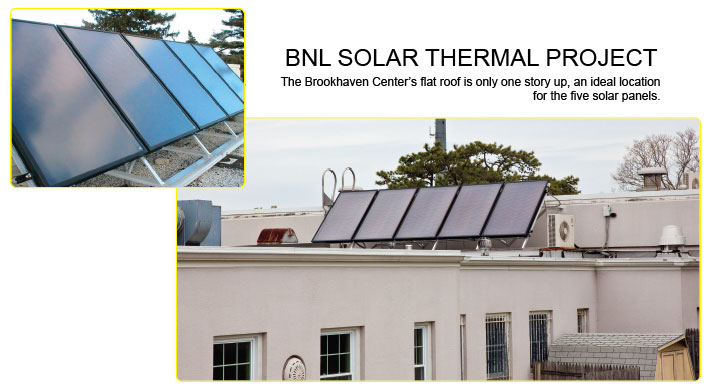 Drainback System
Drainback SystemAs mentioned above, the roof solar thermal panels use a drainback system, in which water drains by gravity back to the storage tank once heat is no longer requested from the collectors.. This means there’s no water in the panels to freeze in the winter. One of the parameters of the project was to avoid the use of antifreeze, so the dry design was essential. Water used is ordinary tap water, with no additives.
The drawback to such a system is that if the panels are dry during a sunny day, they can get too hot to use. If they become too hot, the system will not circulate water through them because they would heat the water instantly to steam, causing unwanted pressure. They have to cool down to a usable temperature before water can circulate through them.
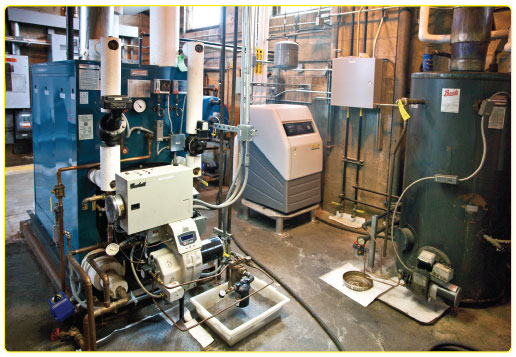
Below, main boiler is at left. HI-efficiency condensing boiler is center and old oilfired water heater is at right.
The building housing the solar thermal project is located some distance from the lab, but Brookhaven has an impressive integrated system in its intranet that allows monitoring of building systems throughout the complex.
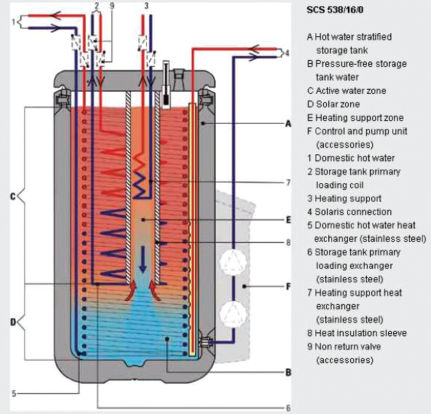
Cross-sectional drawing above of integrated Storage Tank showing how three coils are employed in greater detail.

The task of finding more efficient boilers, heat exchangers, burners and the like will become easier in the Energy Conservation Group’s new lab. In a short while, the team that tests the latest developments in home and commercial heating will be moving to new, larger quarters. The new building will house two key research laboratories where a number of boilers can be set up for efficiency testing. This is the part of the division that provides research for various clients, such as NORA, DoE, NYSERDA and the like.

Lab D7